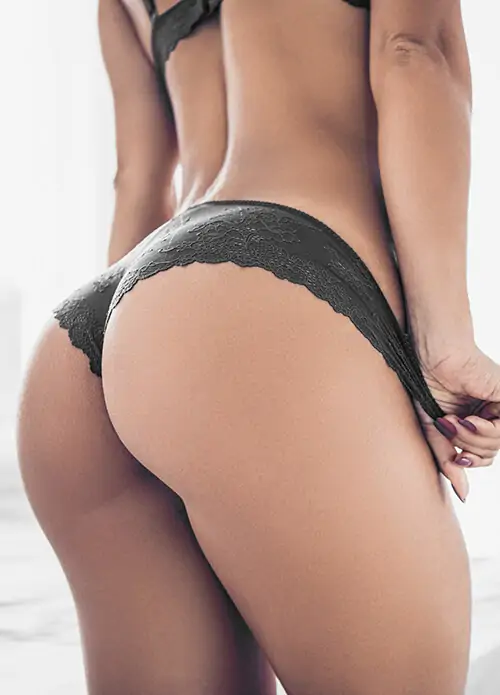About
Sometimes, male breast reduction surgery patients can be treated by liposuction alone, or liposuction can be combined with direct excision of the underlying excess fat or excess breast tissue. Direct excision of fatty tissue can be performed through a small incision along the areola-skin border on the chest.
For male breast reduction surgery patients who have had massive weight loss (i.e. post-bariatric surgery patients), excision techniques removing skin and subcutaneous fatty tissue are sometimes performed. There are several different male breast reduction techniques to treat gynecomastia that can be used to accomplish this for Dr. Wallach’s Manhattan New York City Plastic Surgery patients. The male breast reduction surgical procedure usually takes between two and three hours with a recuperation time of one to two weeks.
Causes of Gynecomastia
There are many causes of gynecomastia. Patients may develop gynecomastia if they are dealing with one of the following causes.
- Hormonal imbalances
- Certain medications like prostate cancer medication and radiation treatment
- Thyroid conditions
- Pituitary gland concerns
- Weight gain
- Chronic kidney disease
- Chronic liver disease
- Testicular tumors
It should be noted that gynecomastia is not a form of breast cancer or not a sign of male breast cancer.
Candidates
A good male breast reduction surgery candidate in New York, NY is any male who is otherwise healthy and is unhappy with the appearance of his chest. When enlarged breasts with excess fat or excess breast tissue begin to affect your self-confidence, feel free to schedule a consultation with Dr. Wallach to know more about breast development and gynecomastia male breast reduction procedures available in New York City.
Consultation
When you schedule your consultation with board-certified plastic surgeon Dr. Wallach, he will talk to you to understand your goals and expectations from the male breast reduction surgery. Your consultation with Dr. Wallach will also consist of an examination to determine the extent of the surgical procedure required to reduce the appearance of male breasts.
Male breast reduction in New York is a cosmetic surgery procedure that consists of different techniques and your board-certified plastic surgeon Dr. Wallach will help you choose the best option for your unique needs.
Risks
The risks of male breast reduction surgery include contour asymmetry or irregularity, partial or complete nipple loss, skin loss, fat necrosis, unfavorable scarring, dysesthesia, infection, fluid collections, hematoma, and the need for further plastic surgery.
Preparation
During a consultation with Dr. Wallach, he usually tells his patients to eat healthy, exercise regularly, and avoid medications and herbal supplements that might cause bleeding.
Testimonials
I had my first consultation with Dr. Wallach in February 2012 to discuss body-contouring procedures after massive weight loss. I had seen two plastic surgeons prior to Dr. Wallach. From the very moment that I received a phone call from the patient coordinator I knew I was in good hands. Dr. Wallach listened and answered all of my questions and was very patient. In May 2012 I had a circumferential abdominoplasty with a fleur d’lis. Dr. Wallach was there every step of the way. I had never met a doctor more dedicated to his patients. While other plastic surgeons were willing to do an entire body lift at once Dr. Wallach would not compromise his patients’ health. He is honest, caring, and above all a very competent surgeon. I would strongly recommend his care to anyone considering a procedure. He is truly an exceptional surgeon, whose expertise far outweighs other surgeons in his field. The quality of Dr. Wallach’s patient care and bedside manner is far superior to that of other plastic surgeons with whom I have consulted, and the passion he exhibits for his profession is second to none. Dr Wallach’s first priority is always patient health and safety, and is unwilling to compromise either for fiscal gain. This is not something I can say about the other plastic surgeons I consulted with, who were willing to perform any elaborate, complicated, and much more risk-laden surgery because “the price was right.” I would not go to any other surgeon and I am looking forward to my next procedure with Dr. Wallach.
Dr. Wallach is an amazing plastic surgeon and I highly recommend him to anyone looking for rhinoplasty.My daughter just had it done and we are beyond happy with the results and she is only a few weeks out!! She had very light bruising and looks absolutely beautiful.Dr. Wallach, Ashley and the rest of his staff are very professional and spent a lot of time making sure all our questions and concerns were answered.I was so nervous for my daughter and Ashely basically held my hand the whole time. I can’t thank you enough for what You did for my daughter…priceless
I was referred to and met Dr. Wallach in late January 2014 regarding having a BBL procedure done, Dr. Wallach easy going personality and professionalism put my mind at ease. I have unique medical issues and after speakina with him I knew he was the perfect physician for my procedure. My surgery was scheduled for mid-February and it went without a hitch. Mind you the day of the surgery there was a big snowstorm; but everyone on the team including myself made it in safely. Dr. Wallach was very informative on the day of surgery: explaining evey step to me and my husband. He was caring and made sure everything was being done to ensure our privacy and that I was comfortable. I must say I was very satisfied with the results and still am. I would definitely go back to Dr Wallach for any future work and would highly recommend him! His office assistant Nicole is a sweet heart and thank them both for the loving care. I have received endless compliments and owe Dr. Wallach a multitude of gratitude!!!!!
God knows I look better than when I first walked in to your office. Thank you thank you thank you for time, skills, and staff. I am beautiful again!
Procedure
Depending upon the cosmetic surgery procedure, your male breast reduction may include liposuction of the area, direct excision of the tissue, or skin or areola tissue removal or reduction.
In general, formal male breast reduction techniques similar to those performed for women might be used in men for one of two situations: 1) where there is actually a breast gland similar to a woman’s, or 2) where a man has lost a significant amount of weight and has excess breast skin and soft tissue with ptotic (sagging) chest skin.
Listed from moderate to severe deformities:
LIPOSUCTION
Liposuction is used for the treatment of the male breast or gynecomastia in men that have good skin tone and a moderate fatty condition. This can be performed using a tumescent technique under local anesthesia or if the patient prefers under general anesthesia. Plastic surgeons make one or two small incisions to gain access for the procedure. Commonly the cannula is also used to disrupt the chest fold to allow for adequate re-draping. New York, NY patients will wear a compression garment after the procedure to help minimize the risk of seroma (fluid) collection.
Recovery from male breast reduction liposuction is like other treated areas, and patients can usually go back to work in a few days. For more information regarding liposuction and gynecomastia, visit our blog.
PERIAREOLAR INCISION TECHNIQUE AND LIPOSUCTION
For male patients in New York City with moderately good skin tone, a moderate amount of subcutaneous fat, but who also may have excess glandular tissue under the areola, may benefit from liposuction performed along with a periareolar incision.
A periareolar incision usually involves an incision along the border of the darker areola skin and the chest skin from the three o’clock position to the nine o’clock position. Plastic surgeons use this incision sometimes when patients have a component of glandular tissue under their areola.
Liposuction does not remove glandular tissue well, and therefore the open technique is usually necessary. Sometimes this is staged when the patient is not sure they want an incision along the border of the areola, or it is unclear if there is sub-areola component of breast tissue. Liposuction complements the male breast reduction procedure to treat the subcutaneous excess fat.
PEDICLE-BASED BREAST REDUCTION
A technique for male breast reduction similar to what is performed in females is sometimes used for men as well. The nipple areola complex can be made smaller in diameter and “carried” on a pedicle of tissue. This pedicle, unlike what is performed for women, is thinned so that when it is placed into the appropriate position, it does not look like a female breast.
During this plastic surgery technique, plastic surgeons remove an ellipse of skin, fat, and breast tissue. The resulting scar is usually transverse with a small scar around the areola. For some thinner men with hanging loose skin, this may not be the ideal procedure, because even with the thin pedicle it still may look like a female breast. The benefit to this male breast reduction technique is that sensation to the nipple may be preserved.
“As an expert in the field of plastic surgery, one of the most rewarding aspects of my career has been listening to my patient’s stories about how having plastic surgery has changed their lives.”
Steven Wallach, MD
FREE NIPPLE GRAFT TECHNIQUE
This gynecomastia male breast reduction technique uses similar incisions as used in the pedicle-based male breast reduction technique, but the nipple-areola complex is replaced as a free graft. There is no actual pedicle of breast tissue so there is less of a chance of having a chest that looks like a female breast. This is good for thinner men with mainly loose skin.
The remaining scars are similar to the pedicle-based technique in that there is a final transverse lower chest scar and a scar around the border of the areola. The main disadvantage to this gynecomastia male breast reduction technique is that the nipple-areola complex will be desensitized and may suffer from hypopigmentation (lighter skin) or even partial loss.
Find The Best Treatment For You
Explore Our Procedures
Recovery
Most male breast reduction patients will have some soreness post-op. Dr. Wallach usually allows his male breast reduction patients to resume showering the next morning. He also instructs patients to avoid aerobic activity for about three weeks and then avoid exertional or upper body activity for about six weeks.
Cost
The fee for male breast reduction surgery will vary based upon the extent of the cosmetic surgery procedure and includes charges for the plastic surgery procedure. This consists of surgeon fees and charges for the operating room. The male breast reduction surgery procedure can be liposuction only, or a combination of liposuction and direct excision of excess glandular tissue, or even involve removing skin and lifting the chest and making the areola smaller.
FAQs
Can guys develop breasts?
Yes men can develop breasts.
Can you get rid of gynecomastia without surgery?
Can gynecomastia be cured without surgery?
Can you reduce breast size without surgery?
If the chest is fatty then diet and exercise can reduce the chest size.
Can gynecomastia grow back after surgery?
This would be highly unusual. If you gain weight, your chest may become larger.
Do you lose weight after breast reduction?
You can lose some weight after a breast reduction.
Does a breast reduction make you look thinner?
A male breast reduction may make the person look thinner.
Does gynecomastia come after surgery?
Gynecomastia does not come after surgery.
How can you tell the difference between gynecomastia and Pseudogynecomastia?
Gynecomastia is having male breast tissue. Pseudogynecomastia is mainly fat.
Does gynecomastia go away with weight loss?
True gynecomastia does not go away with weight loss.
How do I know if I have gynecomastia?
Gynecomastia is a diagnosis by exam of glandular tissue.
Does gynecomastia surgery leave scars?
Gyencomastia surgery can often be performed through a small incision along the border of the areola.
How do I know if I need a breast reduction?
It is a personal choice based upon the appearance of the chest.
How can gynecomastia be prevented?
Gynecomastia can not be prevented.
How do you shower after gynecomastia surgery?
Usually patients can shower the next day.
How long do you have to wear a compression garment after gynecomastia?
I prefer patients wear a garment for 3-6 weeks.
How long does it take to recover from male breast reduction?
Usually patients can go back to light duty within a few days after surgery.
Is it worth getting a breast reduction?
It is a personal choice to undergo a breast reduction.
What causes gynecomastia in males?
Gynecomastia can be due to hormones and genetics.
What is the best treatment for gynecomastia?
Usually the best treatment is direct excision.
How many cup sizes can you go down with breast reduction?
It is hard to predict how many cup sizes you can go down after a breast reduction.
When should I start massaging after gynecomastia surgery?
I do not usually recommend massage after gynecomastia surgery.
My 14-year-old son has some breast development. Can he have this surgically treated?
Many young men develop some breast growth during puberty and the majority of this growth resolves on its own. On rare occasion gynecomastia may be the result of a hormone imbalance, and evaluation by a pediatrician is sometimes recommended. If breast tissue still remains after puberty then I will treat the gynecomastia surgically. Sometimes it is treated with liposuction alone. Other times, a small incision at the areola border may be required to directly remove the tissue.
I am an adult male with large breasts. Will I need a lot of incisions to correct this problem?
The surgery is individualized for each patient. Some patients do very well with liposuction alone. Some patients require an additional excision of tissue underneath the nipple, which is more fibrous tissue and does not get removed successfully with liposuction. This can be accomplished with a small incision along the border of the areola and chest skin, and usually heals very well. Still, there are other patients who have significant skin redundancy and need a reduction with some skin removal.
What is gynecomastia, and is there a treatment?
Gynecomastia is a condition in which the male chest grows larger than normal. This condition is usually benign. It can be due to an increase in the fatty or glandular tissue content of the breast. Occasionally, male hormone levels are not normal and they develop glandular tissue. In these cases, the patient needs to be evaluated by an endocrinologist and possibly put on medications to regulate the hormone levels. Various techniques can treat gynecomastia surgically that are not hormone related. These specific techniques used are predicated upon numerous factors including: 1) the quality of the tissue being treated – if the tissue feels more fatty than glandular, 2) the quality of the skin – if the skin is loose or the chest skin is sagging, 3) the location of the nipple – if the nipple needs to be repositioned, and several other factors.
Can I have liposuction only to treat my gynecomastia?
In many situations, liposuction is a great procedure to offer patients that have gynecomastia. The best candidates for liposuction are those that have primarily a fatty component to the chest, a good nipple position, and reasonably good skin quality. If a patient has excess, loose skin, or sagging in the chest, they are probably better off with an alternative technique that requires a skin excision or nipple repositioning procedure. Patients with a more glandular component and no loose skin might be better off with a direct excision of glandular tissue through a periareolar approach in conjunction with liposuction. In borderline patients where there is some glandular tissue and moderate loose skin, I often will do liposuction first to see how the tissues respond. This minimizes incisions and often gives a good result that patients are happy with, and avoids large chest incisions. If a second stage is needed to perform a glandular excision or a skin excision in these borderline cases, then they can be done three to four months after the first procedure.
When does someone require excision for gynecomastia?
There are different reasons why a patient may require an excision, and there are different techniques depending upon the various anatomical conditions. If a patient has a glandular component of tissue under the nipple areola complex that is not amenable to liposuction, then a small incision along the lower border of the areola is performed. This is called a periareolar incision. If the patient has large amounts of tissue that look similar to female breasts, or had massive weight loss which created sagging chest skin, then various excision patterns can be used to improve the appearance and flatten the chest. Techniques similar to some standard breast reduction techniques can be performed. The tissue can be excised and the nipple areola complex can be left on a thin tissue pedicle. The nipple areola complex is delivered into a position higher on the chest, so that there is an incision on the lower chest fold and around the border of the areola. A free nipple graft technique removes the excess tissue and skin, leaving an incision on the lower chest fold, and the nipple is sited onto a higher chest position. The incision closures are similar to the pedicled technique.
I have loose skin on my chest after massive weight loss. What type of operation will I need?
After massive weight loss, many men have loose, hanging skin on their chests. Treatment commonly requires excision of the skin and glandular/fatty tissue that remains. Two techniques commonly used are: 1) a thin inferior pedicle reduction, or 2) a free nipple graft reduction. Both use similar incisions on the chest. One incision runs transversely along the lower chest fold, and the other circumscribes the border of the areola. The inferior pedicle technique may leave a narrow base of thin tissue under the skin closure to support the blood supply to the nipple and areola. This technique may allow for continued nipple sensation. The free nipple technique leaves thinner flaps of tissue, but the nipple will not have sensation because it is completely detached and re-applied to the chest as a free graft.
Where is the incision made for gynecomastia surgery if one requires tissue excised?
For patients with moderately good skin tone that have little to no excess skin, and have some glandular tissue not amenable to liposuction, an incision along the border of the areola may be used to remove the glandular tissue in a periareolar fashion. This incision is like a smile along the lower border of the areola. Patients with loose or excess skin may require a free nipple graft procedure with another incision along the lower chest fold, or they may have a pedicled reduction with the incision in the same place.
What is a free nipple graft reconstruction for gynecomastia?
A free nipple graft procedure for gynecomastia entails removing the nipple areola complex from the chest skin and using an incision along the lower chest fold to elevate the skin away from the glandular tissue. The excess tissue is removed and the skin is pulled inferiorly towards the incision and tailor tacked. The nipple areola is then placed back on the chest and secured as a free graft. This technique will often get the flattest chest for those with excess skin and gland/fat. The main disadvantage is that the nipple usually will not regain sensation, and it may lose pigment.
What is a pedicled reduction for gynecomastia excision?
A pedicled reduction for gynecomastia is an alternative to a free nipple graft procedure when a patient has excess skin and gland/fat. A very thin pedicle of tissue is created around the nipple areola so it can survive, and the superior skin flap is elevated away from the underlying gland. The excess gland is removed, and the skin is brought over the pedicle. The skin is secured to the lower incision and the nipple areola complex is brought out through the skin at an appropriate site. The main disadvantage is it may leave a bit more tissue underneath the skin flap, which could be visible. However, sensation may remain in the nipple areola complex.
Will I need drains for gynecomastia surgery?
Drains are commonly placed in techniques that require undermining of skin flaps such as when using an inferior pedicle technique or the free nipple graft technique. It is not common to use drains after liposuction. However, some may be used when a periareolar access incision is employed for tissue excision. The drains are normally removed when the drainage is considered low enough.
What is the recovery like for gynecomastia surgery?
Recovery varies from patient to patient. In general, patients are placed in compression garments or ace wraps. If they had a free nipple graft procedure, then they will have small bolsters on their chest. The bolster is removed a week after surgery. Compression garments are worn for the other procedures usually for three to six weeks. Most patients can go back to work within a week. Light aerobic activity can resume within three to four weeks, heavy exertion and lifting within six to eight weeks.
Do I need a compression garment for gynecomastia surgery?
I prefer patients to wear compression in some instances, usually after a liposuction procedure. I recommend patients wear a compression garment for three to six weeks continuously. Depending on the type of procedure, I may have some wear one either immediately after surgery or a few days later. For free nipple graft procedures, I sometimes have patients wait until the bolsters are removed before wearing a compression garment.
Can I have nipple or areola reduction only?
During many gynecomastia procedures in which skin and glandular tissue are removed, an areola reduction can be performed. If a patient has an isolated issue like enlarged areolas, it is possible to perform a circumareola reduction only. For those with enlarged nipples, I reduce them directly. Nipple reduction can often be done under local anesthesia and has a high satisfaction rate.
Is gynecomastia surgery painful?
Usually, gynecomastia is not particularly painful.
How long does it take until the swelling goes down after gynecomastia surgery?
Most swelling will go down within 3-6 wks but might last for 6 months or longer.













